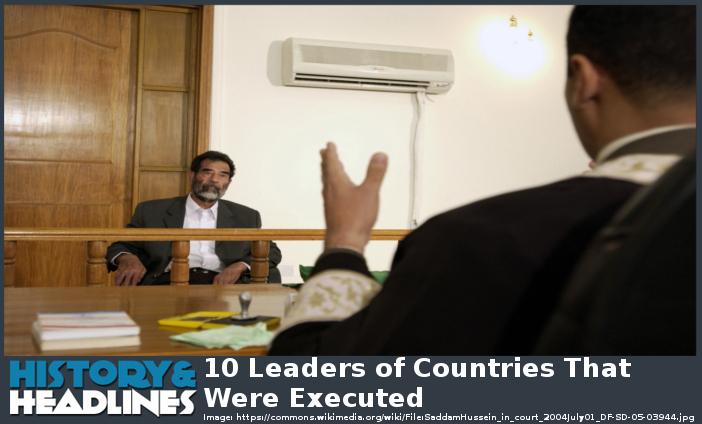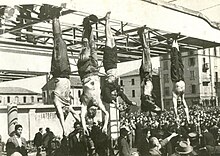A Brief History
On December 30, 2006, former dictator of Iraq, Saddam Hussein, was hanged in a gruesome execution that nearly severed his head from his body. In the aftermath of the terror attacks on the United States on September 11, 2001, the US alleged Iraqi involvement with those attacks and by 2003 the US led a coalition of nations in an invasion of Iraq, eventually arresting Hussein in December of 2003, with the newly installed Iraqi government executing the reviled dictator 3 years later. Many national leaders have been executed throughout history, usually by their own people. Today, we list 10 notable examples of heads of state being executed or murdered after being deposed (rather than assassinated).
Digging Deeper
1. Saddam Hussein, Iraq, 2006.
A brutal dictator that lusted after nuclear weapons, the excuses for invasion of Iraq in 2003 included his supposed continued nuclear weapon program, an allegation proven false. Hussein also used poison gas against Iran in the war between Iraq and Iran, and had allegedly gassed some of his own politically unreliable people. Hussein had nothing to do with the 9/11 attacks, but he was a generally terrible person that imprisoned, tortured and executed his political enemies. When the US overran Iraq, many of Saddam’s cohorts were captured or killed, including both of Hussein’s sons. Saddam was put on trial by the new Iraqi government and executed by hanging, which nearly tore through his neck, leaving a gruesome, gaping wound.
2. King Charles I, England, Scotland and Ireland, 1649.
On the throne since 1625, Charles had the bad luck to be King during the English Civil War, when the Parliaments of England and Scotland rebelled against the monarchy. Charles was captured in 1645 when he surrendered after being defeated militarily. He refused the demand to create a constitutional monarchy, and was held prisoner until he escaped in 1647. Recaptured and re-imprisoned on the Isle of Wight, where he plotted with Scottish conspirators to regain power. This effort to restore his crown failed, and Charles was tried for treason in January of 1649 and executed by beheading with one crisp stroke. He had requested to wear 2 shirts to the execution so that he would not shiver in the cold, lest he make the crowd believe he was fearful.
3. King Edward II, England and Ireland, 1327.
The reign of Edward I was marred by conflict with Scotland (the subject of the 1995 movie, Braveheart) which continued into the reign of his son, Edward II, who was crowned in 1307. Prior to ascending to the throne, Edward II became friends with knight in the royal court, a possibly homosexual relationship that resulted in Edward I banishing the knight from the court in 1306, just prior to the marriage of Edward II to Isabella, the daughter of the French King. A subject of historical debate, allegations of homosexuality regarding Edward II are first found in writing after his death. The return to court of Edward II’s friend/lover, Gaveston, now an Earl, was met with opposition by the Barons of the country and of France, both of which resented the seemingly inappropriate influence of Gaveston. A crushing defeat of the English Army by the Scottish forces of Robert the Bruce undermined Edward II’s power, and a civil war broke out in 1321 (Despenser War) marked by convoluted alliances among factions. Then, Edward II had to deal with war with France during which Isabella traveled to France supposedly as an emissary, but in reality for her own purposes. Returning to invade England with a French army for her own benefit, defeating the English and capturing Edward II in 1327. Faced with the problem of how to legally remove an English King, a solution was to allow Edward II to abdicate in favor of his son, which Edward tearfully agreed to. Edward II died while in custody of suspicious circumstances, largely believed to have been killed by his jailers for conspiring to escape and regain power. The method of execution is reputed to have been the insertion of a red hot poker into the King’s anus and up into his insides! This gruesome death may have been “punishment” for alleged homosexual behavior.
4. Queen Jane, England, 1554.
Also known as Lady Jane Grey, this poor woman was “queen” for only 9 days before being usurped and was executed by beheading several months later. Replaced on the throne by Queen Mary I, Jane was given a reprieve on her death sentence, but the reprieve was revoked when her father became involved in a plot against Queen Mary. Jane was a well educated woman for her day and is often portrayed as an unfortunate pawn in the struggle for control of the throne after the death of King Edward VI. She had reportedly only reluctantly gone ahead with the placing of herself on the throne, a decision she quickly regretted!
5. Mary, Queen of Scots, 1587.
Mary occupied the throne of Scotland from 1542 to 1567, when she was forced to abdicate after an uprising in response to Mary’s husband being blown up in his own garden (murdered). The imprisoned Mary fled to England for the protection of Queen Elizabeth I, her own cousin. Fearing conspiracy to undermine her own reign by Mary since Mary had previously laid claim to the throne of England, Elizabeth kept Mary in custody for the next 2 decades, finally having Mary beheaded in 1587 for plotting to usurp Elizabeth. Mary had been a devout Roman Catholic, and Elizabeth was a fiercely anti-Catholic Protestant, and was always fearful of efforts by Catholics to depose Protestant rule in England.
6. Benito Mussolini, Italy, 1945.
This flamboyant and egotistical dictator of Italy, in power since 1922, led Italy into the abyss of World War II with visions of grand victories and land grabs. Bad for him, the Italian military was not properly prepared for war and was foiled at most attempts at conquest (Except Ethiopia), resulting in the invasion of Italy in 1943 and the popular uprising against his dictatorship. Reinstalled as a puppet of Germany, Mussolini tried to flee when the end of the war loomed, but was caught along with his mistress by Italian communist partisans who shot both of them the next day. Their bodies were displayed in a most unflattering way, hung upside down. Mussolini’s body had been subjected to abuse and scorn, kicked, spat upon and stoned before being hung up for display. He died only 2 days before his erstwhile comrade in arms, Adolf Hitler, committed suicide along with his new wife, Eva Braun.
7. Vidkun Quisling, Norway, 1945.
This man’s name has become synonymous with “traitor,” so reviled is he. When the Germans invaded Norway in 1940, Quisling attempted to seize power and later got his wish when the Germans installed him as a puppet head of Norwegian government from 1942 to 1945 as Prime Minister. Like many collaborators, Quisling was tried for treason and executed by firing squad within a few months of the liberation of Norway. One of his crimes was partaking in the genocidal “Final Solution” gathering up and murdering of Europe’s Jews.
8. Czar Nicholas II, Russia, 1918.
After joining in the disaster of World War I, the Russian people had suffered greatly and were ripe for rebellion, a revolutionary zeal that had existed even before the hardships of the Great War already being present. Forced to abdicate in 1917 during the Russian Revolution, Nicholas had overseen the decline of Russia from a major power to a starving hulk of giant, inept country. Nicholas and his entire family were executed by firing squad by their Bolshevik captors in 1918 to ensure no remaining pretenders to the throne would survive to present a future threat to the Soviet government. The Russian Orthodox Church venerates Nicholas and his family as martyrs. Nicholas had earned the ire of his own people by failed reforms, disastrous war with Japan, and brutal suppression of dissent. He also allowed murderous pogroms against his Jewish subjects.
9. Imre Nagy, Hungary, 1958.
The communist leader of Hungary from 1953 to 1956, Nagy was deposed after the failed 1956 Revolution when the Soviet army invaded to keep Hungary in the Soviet Bloc. Jailed and tried for treason, Nagy was executed in 1958 by hanging after a secret trial. His trial and execution was not revealed to the public until after the fact. The execution of Nagy was a warning to the communist puppets of the Soviet Union that those leaders better keep their people in line or the Soviets would do it for them. Nagy was buried face down with his hands and feet bound by barbed wire, and no commemorations were allowed until the eve of the fall of communism in 1989 when Nagy was “rehabilitated” and given honors, including reburial, attended by 100,000 Hungarians.
10. Maurice Bishop, Grenada, 1983.
In 1979, Bishop led a revolution in the small Caribbean island nation of Grenada, successfully seizing power and was seen as the legitimate ruler of the country by his fellow Caribbean leaders. In 1983 his rule was usurped by a coup orchestrated by his own Deputy Prime Minister, who was in turn deposed only 3 days later by the military. Bishop had been held under house arrest after the coup, but soon escaped, only to be recaptured quickly and executed by firing squad. The chaotic situation in Grenada led to appeals by other Caribbean nations to the United States to step in to restore order. In the US, concern for the welfare of American medical students in Grenada as well as the introduction of Cuban workers and soldiers contributed to the decision to invade the island by the US. In May of 2009 the International Airport in Grenada was renamed after Maurice Bishop.
Question for students (and subscribers): What unlucky world leaders would you include on this list? Please let us know in the comments section below this article.
If you liked this article and would like to receive notification of new articles, please feel welcome to subscribe to History and Headlines by liking us on Facebook and becoming one of our patrons!
Your readership is much appreciated!
Historical Evidence
For more information, please see…
Ashley, Mike. A Brief History of British Kings and Queens: British Royal History from Alfred the Great to the Present. Running Press, 2003.
Fang, Bay. “When Saddam ruled the day.” U.S. News & World Report. 11 July 2004.
The featured image in this article, a photograph by SSGT D. MYLES CULLEN, USAF of former and deposed President of Iraq, Saddam Hussein, sitting before an Iraqi judge at a courthouse in Baghdad, Iraq, is a work of a U.S. Air Force Airman or employee, taken or made as part of that person’s official duties. As a work of the U.S. federal government, the image or file is in the public domain in the United States.












